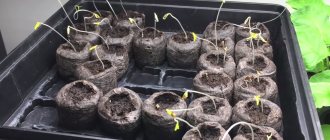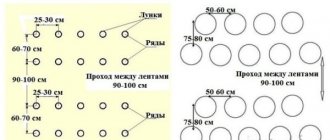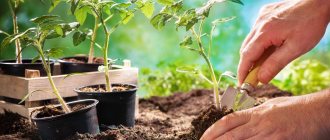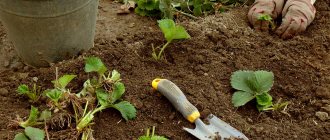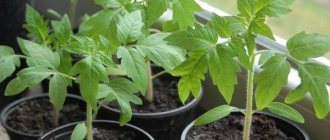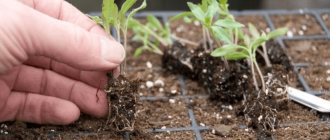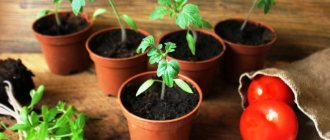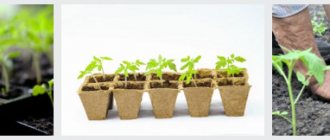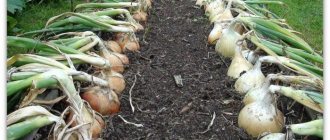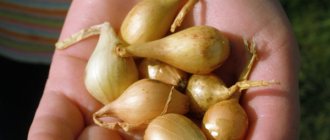Perhaps the most popular crop among gardeners is tomatoes, and most often they are grown in a greenhouse. Some hobbyists purchase seedlings on the market, but their quality is not always the best.
Professional gardeners prefer to sow tomatoes for seedlings for greenhouses themselves. This is a labor-intensive process, and it takes a lot of time, effort and requires unprecedented patience, but it is worth it, because the number of tomatoes collected directly depends on the quality of the planting material.
Self-sowing tomatoes as seedlings for a greenhouse has many advantages:
- Confidence that exactly the variety that was sown will grow;
- Possibility to reject weak plants.
Land preparation
Soil for growing tomatoes can be purchased in specialized departments. It contains nutritional supplements, and after germination the tomato seedlings do not have to be fed.
You can use soil from your own greenhouse, after calcining it in the oven. But you should not take the soil on which nightshade crops (eggplants, tomatoes, potatoes) grew. Tomatoes love loose sandy soils with moderate acidity.
To prepare such soil yourself and sow tomatoes for seedlings for the greenhouse, you should mix greenhouse soil, river sand and humus in equal proportions in the fall. It would be useful to add ash and dry eggshells ground into flour.
Also, when planting tomato seedlings for greenhouses, you can use another composition:
- Turf 70%;
- Humus 45%;
- Ash, chalk, egg shells 15%.
Peat tablets have also proven themselves well. Even when tomato seedlings for greenhouses grow, when transplanted into the ground, the roots of the plant are not injured, and they quickly adapt to new conditions.
Time to plant tomato seedlings for a greenhouse
The best growth of tomato seedlings is observed at an air temperature of 23-26˚C during the day and 16-18˚C at night. Most regions experience these temperatures for a short period of time. That is why it is recommended to sow tomatoes as seedlings for greenhouses at home, and then plant the stronger bushes in the greenhouse. The date to plant tomato seedlings for greenhouses in their permanent place depends on the weather. Typically, plants are planted on May 5-10.
To ensure that your efforts are not in vain, you should take a responsible approach to choosing tomato varieties.
Important! The variety must be adapted to the climate of the region in which you live.
The information provided by the manufacturer must be carefully reviewed. The shelf life and ripening period of a given variety are important. Frost resistance, germination and productivity of the variety are also important. When you need to plant tomato seedlings for a greenhouse, you should not take seeds for open ground.
It’s not bad if the package says F1. This means that this is a hybrid resistant to some tomato diseases.
How to know when seedlings are ready to be transplanted into a greenhouse
When the temperature outside stabilizes and the threat of severe frost passes, the seedlings need to be transplanted into a greenhouse. At this point, the tomatoes must meet some requirements:
- The height of low-growing tomato varieties should be about 15 cm; for tall tomatoes, 30-centimeter seedlings are considered the norm.
- By the time of transplantation to a permanent place, the stems should have at least eight true leaves.
- The diameter of the stem of a strong seedling should be approximately the size of a pencil.
- The bushes already have one or two ovaries with flower buds, but there are no small fruits yet.
- The leaves are tight, bright green, without damage or spots.
Advice! If you buy seedlings, you do not need to choose tomatoes with too thick stems and dense leaves. Such tomatoes look presentable, but they will bear fruit poorly, since they are oversaturated with nitrogen fertilizers and growth stimulants.
Seed treatment
When the time comes for planting tomato seedlings, select the largest seeds, discarding the dried and broken ones.
Before sowing tomatoes as seedlings for the greenhouse, it is necessary to cull the seeds. To do this, they are placed in a bowl and filled with salted water. Seeds that rise to the surface can be thrown away; they are empty and will not sprout. The remaining seeds must be disinfected against diseases; for this, a pinkish solution of manganese is used.
You can treat the seeds with aloe juice. To do this, you need to mix the leaves of the plant, ground in a blender, with filtered water in equal proportions. Place the seeds wrapped in gauze in the resulting pulp for 12-14 hours. This procedure helps:
- Accelerate germination;
- Regulate metabolic processes;
- Additionally disinfects.
Sowing time
Sowing should be done no earlier than two months before planting in the greenhouse. Otherwise, due to a lack of sunlight, instead of strong and healthy tomato seedlings, you may end up with stunted blades of yellow-green color that creep along the ground. Such tomatoes most likely will not survive transplantation.
The time for planting tomato seedlings for a greenhouse will be indicated by a calendar displaying the lunar phases.
Sowing is done in the second phase of the waxing moon. Seedlings planted during this period are stronger and taller, have better disease resistance and produce a richer harvest.
Advice! It is not recommended to plant tomato seedlings during the full moon.
When to plant tomato seedlings for a greenhouse depends on the plant variety:
- Tall tomatoes (Midas, De Barao - time until fruit ripening is 130-140 days) can be sown starting in mid-February;
- Early and mid-ripening varieties (Geisha, Bourgeois - time until fruit ripening is 100-110 days) should be sown in March;
- Low-growing and very early tomato varieties (Valentina, Gina - time until fruit ripening is 87-95 days) can be sown in April.
The timing of growing tomato seedlings for a greenhouse can vary dramatically among different varieties.
What to sow tomatoes for seedlings in a greenhouse
It is convenient to grow tomato seedlings for greenhouses in separate containers (cups). In this case, the seedlings do not need picking and are less injured.
But if it is not possible to provide uniform illumination to all the sprouts (there is not enough space on the windowsill), then it is more advisable to sow tomatoes as seedlings for the greenhouse in a large container.
Tomato seeds are sowed for seedlings in a container filled with damp soil, the seeds are laid out at a distance, sprinkled with soil and compacted a little. If tomatoes are sown in peat tablets, they are first soaked in settled water for an hour.
Advice! When planting tomato seedlings for a greenhouse, the soil should be warmed to room temperature and have good drainage.
Sowing tomatoes for seedlings for a greenhouse:
- Sowing of prepared tomato seeds for seedlings is carried out in a container filled with moist soil, the spread seeds are laid out at a distance, sprinkled with a thin layer of earth and pressed down;
- If the seeds are immersed in a peat tablet, then a small hole is made in its center;
- The container with the sown seeds is tightly covered with film or glass to ensure a greenhouse effect (27-29 degrees). Under such conditions, the seeds will hatch within 4-5 days. At an air temperature of 24-26 degrees, the first shoots will hatch in 8-10 days. In a cool place, the sprouts will have to wait about two weeks;
- The container is transferred to a warm place and the ground is periodically ventilated by lifting the glass. If this is not done, the soil will become covered with mold fungi and the tomato seeds will rot;
- After the sprouts appear, the glass is removed and the box is placed on a well-lit windowsill. At this time (the appearance of 10-15 sprouts), it is recommended to lower the ambient temperature to 15-17 degrees, otherwise the seedlings will be strongly pulled upward. If the lighting is not enough, you need to use a fluorescent lamp to additionally illuminate the tomato seedlings;
- When the bulk of the seeds germinate, the temperature in the room where the tomato seedlings are located rises again to 19-21 degrees. This is the optimal climate for its full development.
Reference! When planting tomato seedlings for a greenhouse, it is worth considering that sudden temperature changes and cold air flows are detrimental to young seedlings.
It is not recommended to water early tomato crops; simply spray the soil with a spray bottle.
When planting seedlings, tomatoes for the greenhouse can also be placed in special polystyrene cassettes.
They have several rows of cells measuring 6x8 cm. Cassettes are convenient because:
- They have a tray, which simplifies the procedure for watering plants;
- To remove tomato seedlings from the cell you do not need to make any special effort. It is enough to pull the stem at the base and pry off the bottom layer of soil with a shovel;
- The root system of bushes transplanted using this method is not disturbed, and they take root better in a new place;
- New cassettes do not require additional disinfection.
An unusual way of sowing
When there is no time to sow tomatoes in the ground for greenhouse seedlings, craftsmen suggest using a different method. For this you will need:
- Multi-layer paper napkins, toilet paper will also work;
- Cellophane strips 10x50 cm. To do this, it is better to cut garbage bags into strips, as they are denser than packaging bags;
Before sowing tomato seedlings for the greenhouse, you need to lay out several layers of paper on cellophane and sprinkle them generously with filtered water from a spray bottle. Stepping back from the edge, place the seeds in the middle of the tape at a short distance from each other. Then the paper is rolled into a loose roll and placed vertically in a container with purified water.
The liquid should only reach the bottom edge of the roll.
After a short time, the seeds will germinate. At the three-leaf stage, tomato seedlings are planted in large boxes with prepared soil.
Growing tomato seedlings in a greenhouse
In the absence of a greenhouse, tomato seedlings can be grown in a greenhouse. A greenhouse is a temporary lightweight structure for growing plants, often without a permanent location. You can buy it ready-made (there are plenty of options), but it’s not difficult to make it yourself from available materials.
Table: differences in growing tomatoes in a greenhouse
| In the greenhouse | In the greenhouse |
| You can plant seeds in the cold season if there is heating. | The timing of possible planting depends on climatic and weather conditions. |
| A person can be inside the greenhouse and carry out various manipulations with seedlings (picking, transplanting, care) | There are no such opportunities |
| It is possible to adjust the illumination and daylight hours | |
| It is possible to transplant seedlings to a permanent place within the same greenhouse without acclimatization |
How to make a greenhouse for growing seedlings
There is no single recipe in this matter - there are many options and they depend on what materials are available to the gardener.
I will share my experience. After the renovation I still had glazed window frames. Every spring, two weeks before planting, I dig several holes around the perimeter of my frames, 30-40 cm deep. I lay the nutrient mixture at the bottom in a layer of 15 cm and lightly compact it. I cover the holes with black film to warm the soil. After warming up the soil, I sow prepared dry seeds in rows at intervals of 15 cm, sprinkle with humus and moisten with settled warm water from a spray bottle. Then I pour a small (10-15 cm) mound of earth around each hole and cover it with glazed frames. I do this at the end of March - beginning of April, depending on the weather. In the event of an unexpected cold snap, sometimes (but not in every season) it was necessary to cover the greenhouses at night with old blankets, straw, etc.
You can do it another way:
- Prepare a bed for seedlings in advance in the fall, preferably a tall one.
- Make a frame of wood or plastic arches around its perimeter and cover it with film or covering material.
- In the spring, two weeks before planting, a covered frame is installed to warm the soil, after which the seeds are sown.
A greenhouse for seedlings can be made from scrap materials
- Then they take care as usual.
Terms and rules for sowing seeds
The timing depends only on climatic and weather conditions. As soon as the desired temperature is established in the greenhouse (this was discussed above), you can begin planting. Planting rules do not differ from greenhouse ones. In this case, you can use a combined method - seeds for seedlings are sown in containers or boxes in advance in a warm room, and as soon as this becomes possible, the plants picked into glasses are placed in a greenhouse for growing.
Seedlings harvested into individual containers can be grown in greenhouses
Seedling care
Watering
When planting tomato seedlings for a greenhouse, the main thing is not to over-moisten the soil, otherwise the roots of fragile bushes may rot. Stagnation of moisture can also lead to drying of sprouts, deoxidation of the soil, oxygen starvation of the roots and the appearance of fruit flies. If the soil retains water, then watering is done with water from a filter once a week. If the soil in the planting container dries out quickly on top, then it is enough to spray the near-root zone with a spray bottle. Water for watering tomato seedlings should be a couple of degrees higher than the ambient air temperature.
Warning! When watering, water should not get on the stem and leaves of the plant, otherwise on a bright sunny day the seedlings risk getting burned, which will negatively affect its further growth.
Top dressing
It is almost impossible to grow tomato seedlings for a greenhouse without fertilizers.
If we talk about feeding, then you need to act based on the appearance of the seedlings. Strong bushes, with a powerful stem and fleshy bright leaves, do not need fertilizers. But too much growth of green mass indicates an excess of nitrogen. The plant will put all its energy into producing green shoots, but it may not be enough for flower stalks.
If the tomato seedlings are pale in color, have a thin stem and small leaves, then they do not have enough nutrition.
Signs of micronutrient deficiency that you can determine yourself
- Leaf fragility results in insufficient nitrogen;
- Leaves of seedlings acquire a purple color due to a lack of phosphorus;
- The light yellow color of the foliage indicates that the plant is not receiving enough nitrogen;
- When leaves wrinkle, there is not enough potassium;
- Yellowing of the tops and the appearance of light specks on the leaves is observed when there is a lack of iron in the soil.
Having assessed the existing problem, you need to select fertilizers. Complex fertilizers have proven themselves well; they contain all the elements necessary for proper nutrition. “Superphosphate” perfectly stimulates the growth of seedlings.
If there is a lack of nitrogen, tomato seedlings are initially fed at the 2-leaf stage. The bushes are actively growing and need nitrogen. Then, fertilizing should be done every two weeks. Urea is well suited for these purposes (1 tbsp per bucket of settled water). The following fertilizing is recommended with “Nitrophoska” and “Azofoska” (tbsp per liter of water).
Important! Nitrogen fertilizers deoxidize the soil, so after fertilizing you should add lime to the soil.
In case of phosphorus deficiency, foliar feeding with superphosphate is carried out. To do this, add a tablespoon of fertilizer to a liter of hot water (90 degrees) and leave for 12 hours. After the time has passed, drain the settled liquid - do not touch the sediment, and dissolve it in 9 liters of water. Tomato seedlings for the greenhouse are sprayed on the leaves with a spray bottle.
Attention! When purchasing fertilizers, you should carefully study the composition. If there are sulfates, then this fertilizer is not suitable for immature seedlings, but is indispensable when feeding tomatoes after planting in a greenhouse.
An important nutrient for tomatoes is potassium. Its deficiency is often unnoticeable, but in the future it will affect the ripening of fruits. Apple-tomatoes are obtained with a greenish, unripe top. Potassium Monophosphate KH2P04 will help correct this. The fertilizer can be called complex; in addition to potassium, it also contains phosphorus, which has a beneficial effect on tomato seedlings. The recommended dosage for foliar feeding is 15 g. on a bucket of water.
A natural fertilizer containing potassium is wood ash.
For 10 liters of water, take 2.5 cups of ash and leave for 0.5 hours, then pour the tomatoes under the root. The highest potassium content is observed in the ash after burning pine or birch - about 15%. But in the ash formed as a result of peat combustion, potassium is present in an amount of 2%. Ash is also rich in calcium (up to 45%), phosphorus (up to 7%), manganese, magnesium and many other elements useful for seedlings.
Warning! An excess of fertilizers in the soil will immediately transfer to the fruits. Then, instead of aromatic and tasty salad from your own greenhouse, you may end up with health problems.
Moon phases and their effect on plants, table of favorable days
Each of the phases of the earth’s satellite affects seedlings, so this point must be taken into account. It’s not difficult to understand all the nuances; if you remember them, you can use the information when planting any other plants. And favorable days for planting tomatoes in 2020 are collected in a table to make it even easier to choose the best periods.
As for the phases of the moon, everything is simple:
- The full moon and new moon are not suitable for any planting work. In addition, you should not sow tomatoes and other crops two days before the start of these cycles and within 2 days after their end. During these periods, you should not work on the land at all unless absolutely necessary, with the exception of loosening.
- The waning moon promotes increased root formation of plants. You can carry out hilling, fertilizing, and also sowing any root crops.
- When the moon is growing, it is best to work with plants that form the ground part. During this period, it is good to sow seeds and transplant seedlings into a greenhouse or open ground.
If there is no exact data, then you should at least be guided by the phases; information on them is in wall calendars and weather forecasts. Even this is enough to improve the emergence of seedlings and provide favorable conditions for plants. The seedlings will be stronger and will develop faster.
For best results, sow during the following periods:
| Month | Better days |
| February | From 10 to 15, from 17 to 20, 24 – 25 |
| March | From 3 to 6, 17 – 18, 22, from 27 to 30 |
| April | From 5 to 7, from 10 to 14, 18 to 19, 23, from 25 to 29 |
Ideally, you should accurately match the dates in the table. But if it doesn’t work out, then proceed from the information on the phases indicated above. In addition, remember unfavorable numbers; during these periods you cannot carry out work at all:
- In February: from 8 to 9, from 21 to 22, 26-27.
- In March: 7-8, from 19 to 21, from 21 to 22.
- In April: 3-4, from 15 to 17, from 20 to 22, 30.
Advice!
It is better not to plant seeds for seedlings and do other work before lunch on the first day of the favorable period and in the second half of the last day.
The easiest way is to determine suitable dates in advance so that they fall on weekends or days when you can set aside a few hours for work. Ideally, prepare everything you need, without wasting time on shopping trips or long searches for containers in the pantry or basement.
Picking
As for picking, every gardener has his own opinion. Some people think that this is unnecessary stress for a fragile plant, and they sow tomatoes directly into separate cups. Others argue that picking is akin to natural selection; the strongest tomato bushes survive.
The positive side of the procedure is that after planting tomato seedlings in larger containers, the root system develops better.
The procedure should be carried out at the stage when the bush has formed three true leaves. But some sprouts develop faster than their counterparts and are ready for transplantation in 7-9 days. However, there is no need to rush, since the root system of the sprouts is still very weak and can be seriously injured. But at the same time, it is worth considering that at the age of 21 days, the roots of densely sown tomatoes begin to intertwine with each other. Picking in this case greatly injures the plants.
Reference! The optimal age of tomato seedlings for transplanting is 12-15 days.
Before transplanting, prepare a container with moistened soil in advance. During the day, tomato seedlings are well watered (this makes the soil not very heavy, as if watering is carried out immediately before the procedure). To remove a tomato sprout from a small bowl, you need to grab it by the base of the stem and gently pull it up, helping from below with a small scoop.
Then lower the bush down to the cotyledon leaves into a previously prepared hole, sprinkle with soil and compact it a little.
When planting tomato seedlings for a greenhouse in peat tablets, when picking, it is necessary to remove the protective film from them and place them in soil prepared according to all the rules.
Planting seeds for seedlings
You need to be extremely careful with sprouted seeds, as the delicate sprouts break very easily. Therefore, you need to germinate seeds on a cloth or cotton pad, and not on a bandage or gauze - the sprouts will easily get tangled in the fibers and break.
You need to transfer the seeds into the prepared grooves using tweezers. Place them at a distance of about 2-2.5 cm from each other - this is approximately the width of two fingers of an adult hand folded together.
Now the seeds are sprinkled with dry soil and compacted a little. There is no need to water the grooves; it is better to use a spray bottle and spray the water on the ground. After irrigation, containers with seeds are covered with plastic film or transparent glass.
Place the pots and boxes in a very warm place where the temperature is constantly maintained at 26-28 degrees.
After 7-10 days, the first sprouts will appear, this is a signal that the film needs to be removed from the boxes.
Caring for tomatoes after transplantation
The first days after the procedure, tomato seedlings should not be exposed to the sunny side; it is better to shade them and increase the room temperature by 2-3 degrees. After adaptation, the sprouts will need maximum light. At this stage, you can take the sprouts out into the fresh air, gradually increasing the time they spend on the balcony.
After 1-1.5 weeks, it is advisable to fertilize. Dissolve 12 grams in a bucket of water. potassium sulfate, 30 gr. superphosphate and 5 g. urea. Fertilizing should be done only after watering.
